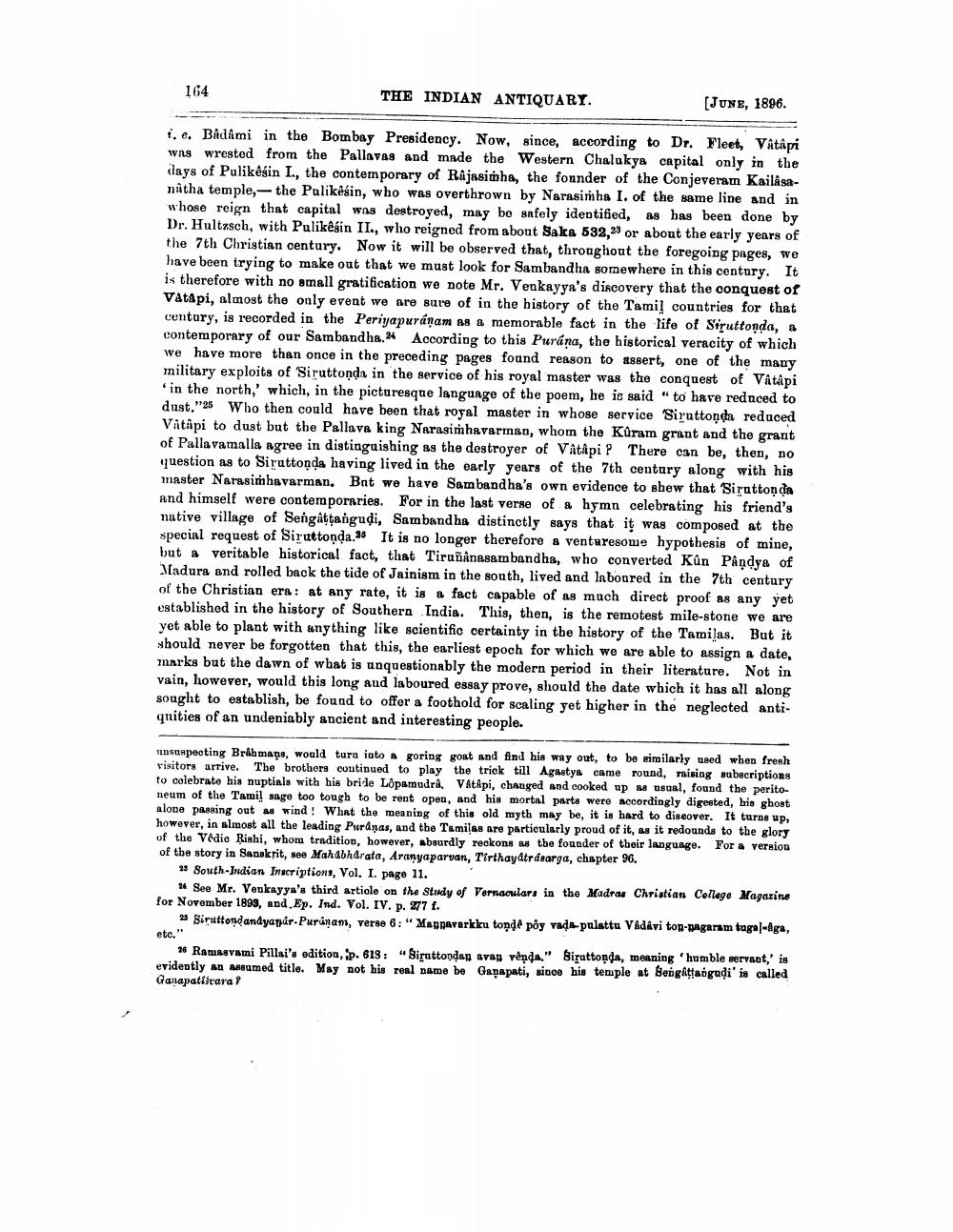________________
164
THE INDIAN ANTIQUARI.
(JUNE, 1896.
1. e. Badami in the Bombay Presidency. Now, since, according to Dr. Fleet, Vatapi was wrested from the Pallavas and made the Western Chalukya capital only in the days of Pulikeğin I., the contemporary of Rajasimha, the founder of the Conjeveram Kailasanitha temple,-the Palikesin, who was overthrown by Narasimha I. of the same line and in whose reign that capital was destroyed, may be safely identified, as has been done by Dr. Hultzsch, with Pulikesin II., who reigned from abont Saka 532,3 or about the early years of the 7th Christian century. Now it will be observed that, throughout the foregoing pages, we have been trying to make out that we must look for Sambandha somewhere in this century. It is therefore with no small gratification we note Mr. Venkayya's discovery that the conquest of Vatapi, almost the only event we are sure of in the bistory of the Tamil countries for that century, is recorded in the Periyapuranam as a memorable fact in the life of Siruttonda, a contemporary of our Sambandha 24 According to this Purana, the historical veracity of which we have more than once in the preceding pages found reason to assert, one of the many military exploits of Sirattonda in the service of his royal master was the conquest of Vatapi
in the north,' which, in the picturesque language of the poem, he is said "to have reduced to dust."25 Who then could have been that royal master in whose service 'Siruttoņda reduced Vitâpi to dust but the Pallava king Narasimhavarman, whom the Kuram grant and the grant of Pallavamalla agree in distinguishing as the destroyer of Vâtâpi ? There can be, then, no question as to Sirattonda having lived in the early years of the 7th century along with his master Narasimhavarman, Bat we have Sambandha's own evidence to sbew that Sirattonda and himself were contemporaries. For in the last verse of a hymn celebrating his friend's native village of Sengåttangudi, Sambandha distinctly says that it was composed at the special request of Siruttoņda. It is no longer therefore & venturesowe hypothesis of mine, but a veritable historical fact, that TirañÂnasambandha, who converted Kün Pandya of Madura and rolled back the tide of Jainism in the south, lived and laboured in the 7th century of the Christian era: at any rate, it is a fact capable of as much direct proof as any yet established in the history of Southern India. This, then, is the remotest mile-stone we are yet able to plant with anything like scientific certainty in the history of the Tamilas. But it should never be forgotten that this, the earliest epoch for which we are able to assign a date, marks but the dawn of what is unquestionably the modern period in their literature. Not in vain, however, would this long and laboured essay prove, should the date wbich it has all along sought to establish, be found to offer a foothold for scaling yet higher in the neglected antiqnities of an undeniably ancient and interesting people.
unsuspecting Bribmaps, would turn into a goring goat and find his way out, to be similarly used when fresh risitors arrive. The brothers continued to play the trick till Agastya came round, raising subscriptions to colebrate his nuptials with his bride Lopamudra, V&t&pi, changed and cooked up as usual, found the peritoneum of the Tamil sage too tough to be rent open, and his mortal parts were accordingly digested, his ghost alone passing out as wind! What the meaning of this old myth may be, it is hard to discover. It turns up, however, in almost all the leading Puranas, and the Tamilas are particularly proud of it, as it redounds to the glory of the Vedio Rishi, whom tradition, however, absurdly reckons as the founder of their language. For a version of the story in Sanskrit, see Mahabharata, Aranyaparuan, Tirthay dtr dearga, chapter 96.
13 South Indian Inscriptions, Vol. I. page 11.
* See Mr. Venkayya's third article on the Study of Vornaoulars in the Madras Christian College Magazine for November 1893, and Ep. Ind. Vol. IV. p. 277 f.
» Siruttondandyapar. Puriņam, verse 6: "Mappavarkku toņde pây vada-pulattu V Adavi top-nagaram tagal-Aga,
etc."
* Ramsavami Pillai's edition, p. 618: "Biruttondag avap rêņda." Birattonda, meaning 'humble servant,' is evidently an assumed title. May not his real name be Ganapati, sipoe his temple at Bengktangudi is called Galapatišrara ?




